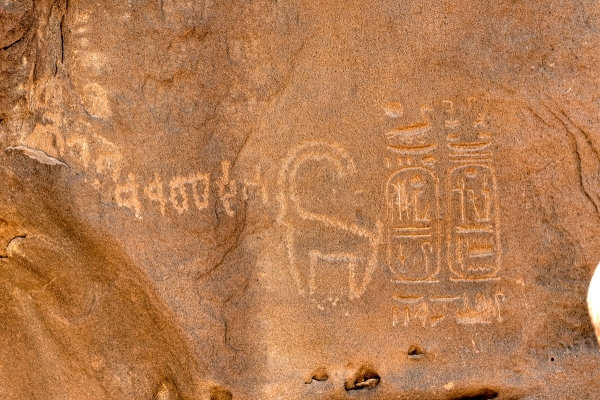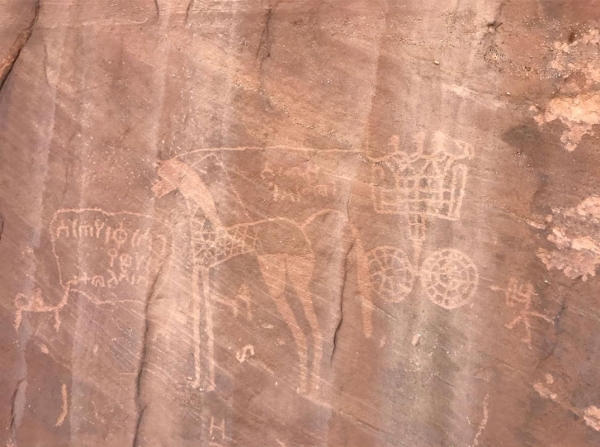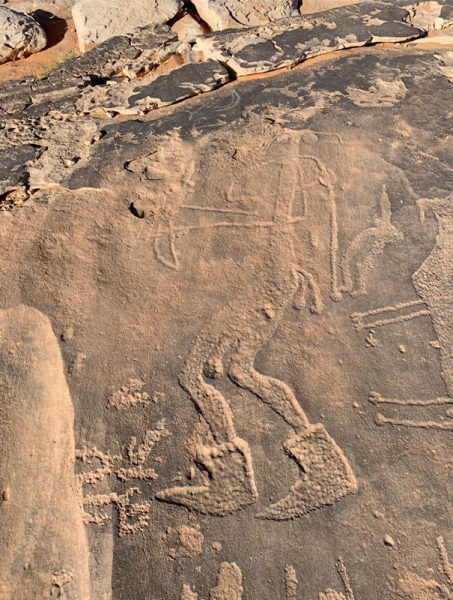



The Rock Drawings and Inscriptions in Tabuk Province are the earliest methods used by humans since ancient times to depict artistic and symbolic images through engraving or carving on rock surfaces or inside caves. They serve as an important source of knowledge about the social, cultural, and religious aspects of ancient humans. The Kingdom of Saudi Arabia is the fourth richest region in the world in terms of rock art, as archaeological surveys have revealed about 1,200 rock art sites in the country.
Tabuk Province preserves a wealth of rock monuments and drawings as it was home to several ancient civilizations and served as a passage for trade routes and human migrations. Almost every mountain along the paths in Tabuk features rock drawings and inscriptions. There are several archaeological sites in the province, including al-Bad', Tayma', al-Wajh, Wadi al-Disah, Qalwa, and the Qariyah site.
The historical significance of rock drawings and inscriptions
Rock inscriptions have helped in identifying the cultural context of the era in which they were created, thereby revealing various aspects of human life during that period. They reflect the domesticated animals and environmental elements present in the surroundings, such as palm trees and ostriches drawings. Additionally, rock drawings and inscriptions served as means of communication among ancient societies, represented by symbols and signs of humans and animals referring to fixed meanings through which events, messages, and incidents were recorded. For instance, the engraving of a snake represents danger, winding lines indicate the locations of water, lions symbolize bravery and each animal drawing has its significance.
Rock drawings and inscriptions in al-Bad'
Al-Bad' Governorate, located west of Tabuk, is known in Islamic sources as 'the Land of Midian', the people of the Prophet Shu'ayb (peace be upon him). It is renowned for the presence of an archaeological site called 'Magha'ir Shu'ayb', an ancient oasis with carved tombs in the mountains. Some of these tombs are simple square-shaped caves, while others feature facades adorned with decorative motifs resembling balconies. Their history dates back to the Nabatean period. Facades in Magha'ir contain numerous rock drawings and inscriptions, which are Nabatean and Lihyanite inscriptions. Additionally, there are traces of a city from the early Islamic period known as 'al-Malqatah'.
Rock drawings and inscriptions in Tayma'
The history of Tayma' Governorate dates back to 1200 BC. In the sixth century BC, Tayma served as the operational capital of the Babylonian Kingdom, during the reign of King Nabonidus. The monuments in Tayma' include some artifacts dating back to the Midian and the Edom periods at the beginning of the first millennium BC, in addition to rock inscriptions dating to the sixth century BC.
Tayma' is famous for al-Naslaa Rock, locally known as "Hasat al-Naslaa," which is one of the geological wonders in southern Tayma'. It's named al-Naslaa because it stands alone, separated from the nearby mountains. It's a rocky mass divided into two halves, shaped conically by weathering and winds. The rock face contains several Thamudic inscriptions and drawings of various animal forms.
Near the oasis of Tayma', the earliest Pharaonic monuments in the Arabian Peninsula were discovered, which was a hieroglyphic inscription on a fixed rock bearing the royal signature of King Ramesses III, one of the pharaohs of ancient Egypt who ruled between 1192 and 1160 BC. This indicates the existence of a direct trade route connecting the Nile Valley to Tayma', which Egyptian caravans traveled through to get the province's famous goods, such as incense, copper, gold, and silver.
Rock drawings and inscriptions in Abu Rakh
'Abu Rakh' Center in al-Wajh Governorate is considered an open-air museum due to the abundance of rock inscriptions in the area. The center and its affiliated areas, including al-Shahiba, al-Nashifa, al-Jaww, al-Jazl, and al-Blaytiha, contain Thamudic, Lihyanite, Dedanite, and Roman inscriptions, in addition to Islamic inscriptions in Kufic script. The region historically served as a passage for pilgrims. Rock inscriptions in Abu Rakh include drawings with symbols and signs like drawings of ostriches and their hunting methods, Arabian oryx, bulls, tigers, lions, and snakes. The drawings also contain a variety of animal shapes such as cows, capras, camels, and horses, alongside drawings of battles that took place in the province.
In the region, rock inscriptions of horses, horsemen, and bows were also found, indicating the passage of trade caravans through this province. Additionally, there are drawings of human figures depicted in various styles, some sculpted entirely, others in schematic form in simple outline, some were drawn abstractly and others include drawings of daggers, swords, bows, and spears.
Rock drawings and inscriptions in Kilwa
Kilwa, located in al-Tubayq Reserve, is approximately 280 km northeast of Tabuk. The region has witnessed widespread human settlement since ancient times, spanning long successive periods, including prehistoric, historical, pre-Islamic, and Islamic eras. The rock art in Kilwa region is one of the oldest monuments in the Arabian Peninsula; the evidence is from the weathered rock surfaces and the impact of weathering. The history of rock art in the Kilwa area dates back to the period between 9000 and 7000 BC.
It is noticeable that flint tools are widespread in Kilwa and the surrounding sites, which can be attributed to the Neolithic period. In its later stages, this period witnessed human attempts at settlement, as evidenced by some simple structures scattered across the site. These settlements gradually increased in subsequent ages.
Rock drawings and inscriptions in Qraiyeh Site
A Saudi-Japanese research team recorded thirty archaeological sites in the valleys and pastoral areas between Tabuk and al-Jawf Provinces, dating back to various eras. These include the Paleolithic Age, the Neolithic Age, the Bronze Age, and the Iron Age, as well as sites from the Islamic periods. Among these sites is Hawd 'Qraiyeh', where settlements dating back to the Neolithic and Iron Ages have been found.
The preliminary results of the studies of the research team revealed semi-stable pastoral activity during those periods, evidenced by the presence of grinding stone tools. Additionally, pottery fragments from the Neolithic, Iron, and Copper Ages were discovered at some sites. Numerous stone tools were also discovered during this survey, including a flint scraper dating back to the Neolithic period.
Rock drawings and inscriptions in Rwafah and ad-Disah
Rwafah region is located 115 km southwest of Tabuk. It contains a temple built in 165 CE, as indicated by a rock inscription on the site, inscribed in both Latin and Nabatean scripts. The inscription indicates that the temple was constructed by the Thamudis to commemorate two emperors. Additionally, in ad-Disah region, an agricultural oasis southwest of Tabuk City, remnants of a Nabatean village, an unfinished facade of a Nabatean tomb carved into the rock, and rock writings, drawings, and inscriptions from different ages were discovered.
Related quizzes
Related articles
